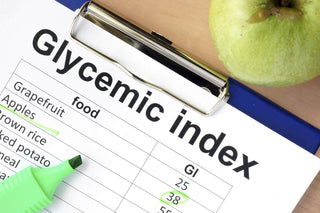If you’ve been avoiding certain foods because you think they might trigger a breakout, you’re not that far off. It turns out that despite being characterized as a “myth,” what you eat may affect your skin after all.
This study provides further evidence that diet plays a role in the development of acne by establishing a link between high-glycemic foods and breakouts.
By monitoring participants’ eating patterns and blood glucose, researchers found that those with a high glycemic load diet experienced more moderate to severe acne, with severity correlating to the glycemic index value.
It adds to all the compelling research showing that high-glycemic foods may trigger acne by not only raising blood sugar levels but also increasing the release of various hormones including insulin, IGF-1 and growth hormone – all of which can exacerbate acne.
Cutting Empty Carbs and Dairy Key for Clear Skin
Researchers also found that acne-prone individuals had lower levels of adiponectin, a protein secreted by adipose (fat-storing) tissue that is involved in regulating glucose levels as well as fatty acid breakdown.
Adiponectin levels are lower among obese people than those who are normal weight, and accumulation of visceral fat, the dangerous fat around the abdomen, is more common. In addition, decreased adiponectin levels may suppress anti-inflammatory substances in the body and promote inflammation like that of acne.
Simple Carbohydrates and GI
The foods that tend to rank highest on the glycemic index (GI) are simple carbohydrates – foods like white bread, white rice, pasta, potatoes, and high-sugar foods. These foods are digested quickly and raise blood sugar quickly as well.
From Simple Carbs to Slow Carbs
A few other factors can affect the GI of a food, including:
Type. Certain varieties of food have a higher GI. For example, converted long-grain white rice has a lower GI than brown rice.
Processing . The GI of foods can increase when processed. Juice has a higher GI than whole fruit, ground grains have a higher GI than whole grain, and mashed potatoes have a higher GI than baked potato.
Cooking. Cooking time can affect GI. Overcooked pasta has a higher GI than al dente pasta.
Ripeness. Fruits and vegetables that are very ripe have a higher GI.
Food is generally classified as having a low (55 or under) or high (70+) glycemic index. You can check the glycemic load/index of your favorite foods here.
Recommendations
So how can you eat to avoid acne?
Try a plant-based diet with a good amount of lean protein like lean meats, legumes, and nuts. Fruits and non-starchy vegetables will provide complex carbohydrates and plenty of fiber while keeping blood sugar levels steady.
Limit dairy and look for dark leafy greens to get calcium and other key nutrients. By doing this, you’ll naturally crowd out unhealthy packaged, processed foods that are high in sugar and unhealthy trans-fats.
Eating a low glycemic diet isn’t just great for your complexion – it’s great for your health, too, reducing your risk of diabetes, heart disease, and even weight gain. So stop the blood sugar rush and start eating for beautiful, blemish-free skin.

